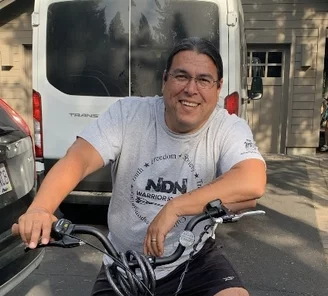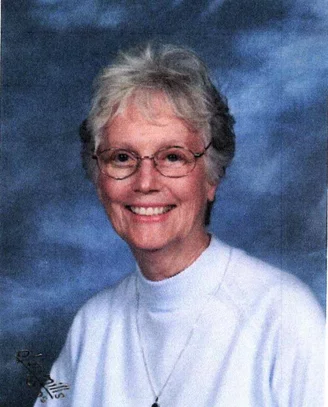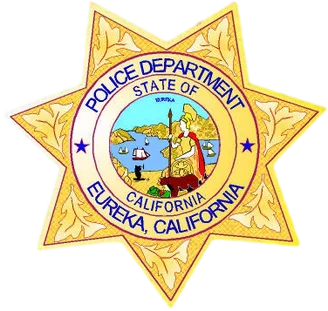OBITUARY: Tracy Jeff Guido, 1975-2024
LoCO Staff / Friday, Jan. 3 @ 6:56 a.m. / Obits
It is with deep sadness that we announce the passing of Tracy Jeff Guido on December 27, 2024, at the age of 49. Jeff was a son, grandson, husband, father, brother, uncle, friend, and mentor, and a proud Yurok tribal member.
Jeff was born on April 16, 1975 to Joanne Moore and Wallace Guido in Portland, Oregon. As a young child, he could be found laughing and playing with his older sister and cousins during summers in Hoopa at the home of their grandmother Awok Violet Moore, who had a big influence on him. He enjoyed camping, football, and monster truck shows.
Jeff was incredibly resilient and overcame adversity by embracing his Yurok culture. He graduated from College of the Redwoods with a degree in substance use counseling. He worked with Native youth at risk in Humboldt County, teaching them to take the Red Road to healing and healthy living, guided by the ways of our ancestors.
He loved participating in traditional dances and was a beautiful singer. He also loved fishing and sharing smoked salmon with friends and family. Throughout his life, he was a role model for many, including his nephew and cousins. He had a heart of gold and a kind, gentle, old soul.
Jeff was preceded in death by his grandparents, Awok Haynes Moore and Awok Violet Moore, his uncle Awok Arnold Moore, his aunts Awok Betty Jackson and Awok Carol DeLaRosa, and cousin Awok Carl Snyder.
Jeff is survived by his mother, Joanne Moore, older sister Joice Moore, niece Isabella Violet Davis, nephew Nicolas Jessen Davis, wife Yvonne Lynn Guido, daughter Trinity Cheyenne Newsom, son Albert Atlas Lewis, grandson James Micah Holt, granddaughter Jamie Lynn Sanders, and bonus daughter Kimora VenPelt. Jeff is also survived by his uncle Bert Snyder and aunt Vivian Snyder, along with his aunt Barbara Orcutt. In addition, Jeff is survived by countless cousins who loved and adored him.
A service will be at the Pecwan family cemetery in Pecwan at 12:30 p.m. on January 4, 2025, followed by a shared meal at the Libby Nix Building in Weitchpec.
Jeff’s life in this world was far too short for those who knew and loved him, but he will be greeted by those who passed before him with loving arms. We will forever hold him close to our hearts.
Service officiant: George Blake
Pallbearers: Nicolas Davis, Jonny DeLaRosa, Dan Rubinoff, Glenn Moore, Sport Surber, Curtis Kane, Zak Brown, Donald Moore
Honorary pallbearers: Kevin Orcutt, Bert Snyder, Pliny “Jack” Jackson III, John Greene, Edward Moore, Phillip Wagner.
###
The obituary above was submitted on behalf of Tracy Guido’s loved ones. The Lost Coast Outpost runs obituaries of Humboldt County residents at no charge. See guidelines here. Email news@lostcoastoutpost.com.
BOOKED
Yesterday: 4 felonies, 14 misdemeanors, 0 infractions
JUDGED
Humboldt County Superior Court Calendar: Today
CHP REPORTS
Us101 / Big Lagoon Park Rd (HM office): Trfc Collision-Unkn Inj
6100 Hwy 101 N (HM office): Assist CT with Maintenance
3227 Mm299 E Tri 32.30 (RD office): Trfc Collision-1141 Enrt
1656 Union St (HM office): Missing Elderly
ELSEWHERE
RHBB: Outbreak of Potentially Deadly Amatoxin Poisoning Linked to Consumption of Wild, Foraged Mushrooms
RHBB: Shasta-Trinity National Forest Continues Prescribed Fires to Reduce Wildfire Risk
100% Humboldt, with Scott Hammond: #100. From Police Logs to Community Legacy with Editor Kevin Hoover
HipHopHumboldt: Episode 68 - Rick Toledo
OBITUARY: Joan Lukenbill Shapeero, 1934-2024
LoCO Staff / Friday, Jan. 3 @ 6:56 a.m. / Obits
Joan Arlene Shapeero of Eureka peacefully passed
away on Dec. 23, 2024.
Joan was born on May 30, 1934 to Wesley and Viola Lukenbill in Tacoma, Washington. She was the eldest of three children. Following graduation from Lincoln High School in 1952, Joan went to work for the telephone company where she worked for four years. In 1954 she met William Shapeero and they married in October 1955. Joan and Bill had two sons, Michael and Patrick. It was a busy household with Bill continuing his education and Joan maintaining a household and raising their two active boys.
When the boys were in their preteens the family moved to Corvallis, where Bill pursued his doctorate at Oregon State University and Joan worked at the University’s Student Health Services. Completing his doctorate the family moved to Eureka, where Bill taught at the College of the Redwoods, and later moved to Hydesville. In 1975 Patrick graduated from high school and Joan completed an Associates Degree in business from the College of the Redwoods. Following her graduation Joan worked for two years as a teacher’s aide in Fortuna.
Joan and Bill divorced after 32 yrs of marriage in 1987. It was a difficult time for Joan but she rented a townhouse close to Pat and his family and soon loved life again, living independently there for over 30 years.
Joan joined Unity Church of the Redwoods, where she met Jim Snow. They soon developed a loving companionship that lasted 25 years until his death in 2013. Joan and Jim enjoyed dinners together, traveling, family holidays and their weekly Saturday breakfast dates at Gill’s By the Bay. Joan joined Jim working in his appliance store for five years until Jim retired.
At the age 70 Joan retired from North Coast Family Practice, where she worked as a medical records clerk for 10 years. Never wanting to be idle, she did volunteer work for another seven years.
Joan’s greatest joy were her three talented granddaughters and she enjoyed sharing their accomplishments with her friends and family. She was very proud of her sons and the life choices they have made.
Joan is survived by her two sons, Michael Paul (Emma) of Bloomsberg, Penn. and Patrick Wayne of Santa Rosa; three granddaughters — Dhyana Wallace (Kenneth Meth), Jordan Rohanna (Will Burner), Emily Shapeero; and Joan’s sister Carol Mikesh (Paul). Joan was preceded in death by her brother Gary.
Joan enjoyed her life and wanted to thank some of those that made that possible. “Thank you so much to the following. My special friends from Unity Church Anne Merryfield, Janette Murphy and Carol Saucier. Jim’s daughters, Jamie Boone, Kim Regalo and their families who have been like a second family to me. Dolly Frye of Frye’s Care Home and her capable staff for all their help. A special thank you to my loving sister Carol for putting together my life’s story.”
There will be a small family gathering in her honor sometime in the spring at Pat’s property in Kneeland.
###
The obituary above was submitted on behalf of Joan Shapeero’s loved ones. The Lost Coast Outpost runs obituaries of Humboldt County residents at no charge. See guidelines here. Email news@lostcoastoutpost.com.
OBITUARY: Joe A. Brown, Jr., 1937-2024
LoCO Staff / Friday, Jan. 3 @ 6:56 a.m. / Obits
It is with deep sadness that the Brown family announces the passing of Joe A. Brown, Jr. Joe passed away peacefully on December 30, 2024, surrounded by his devoted wife and daughters. He will be missed immensely by all that knew him.
Joe was born in Mendocino on June 6, 1937, to Joe and Mamie Brown. Joe joined the Navy right out of high school and on one of his leaves he came home to propose to his wife of 67 years, Diana. They were married in Reno and not long after, Diana joined Joe in Hawaii where their daughter, Debbie, was born. After Joe’s honorable discharge, the family welcomed their second daughter, Doreen, and in 1962 moved to Eureka to start a new life. He started his career of meat cutting at Purity Grocery Store then moved on to Safeway where he spent the remainder of his career. He developed many friendships throughout the years through work, golfing, bowling, and the community. Joe was a sports enthusiast and throughout his life he played and watched all sports. For years you would find him on the golf course at 7 a.m. every day.
Above all, Joe cherished moments with his loved ones. Joe is survived by the love of his life and wife of 67 years, Diana Brown; his daughters, Debbie Brown and Doreen Parker (John); his grandchildren, Megan Pilipovich (Vitaliy), Ryan Combs (Kayla), Trent Combs (Ashley), Kasidy Parker (Vincent); great-grandchildren, Isaac, Josie, Dylan, Mason and Gracy; brother Andy Brown; many nieces and nephews; as well as his beloved dog Lucy.
Joe’s family will forever miss his kind smile, support, and unconditional love. Though he is no longer with us, his memory and legacy will live on in the hearts of those who were fortunate enough to know him.
In accordance with Joe’s wishes, no services will be held. The family requests that those who wish to honor his memory consider spending a morning on the golf course or donating to Sequoia Humane Society in his name.
###
The obituary above was submitted on behalf of Joe Brown’s loved ones. The Lost Coast Outpost runs obituaries of Humboldt County residents at no charge. See guidelines here. Email news@lostcoastoutpost.com.
OBITUARY: William Andrew Nickols, 1938-2024
LoCO Staff / Friday, Jan. 3 @ 6:56 a.m. / Obits
William
Andrew Nickols
June 19, 1938 - Dec. 19, 2024
William Andrew Nickols, better known as Bill, son of Albert and Ailene Nickols, was born in Scotia. Bill is preceded in death by parents Albert and Ailene, and brothers Jim Nickols, and Albert Nickols.
Bill was a lifelong Humboldt native and graduated from Eureka High school and then Humboldt State University in 1960 with his teaching credentials. He played football throughout his life and is recognized in the HSU Hall of Fame.
Bill served as the Humboldt County Constable in the 1970s. After college he attended barber school, earning his certificate and then barbered for nearly 50 years. His barbershop was as much a social gathering place as it was a place to get your hair cut.
When Bill was not at his barber shop you could find him at the family property in Ruth Lake, Nickols Big Oaks. He loved being at Ruth and spent most of his life enjoying the outdoors. Whether it was taking his children or grandchildren hunting and fishing, Bill’s favorite times were at Ruth.
Bill has always been a man of countless friends. Everywhere he went in the community, he was quick to make friends, and even quicker to say something that brought a smile to your face.
His easy-going attitude will forever be missed. Bill is survived by his sister, Vivian Christian; children Shawn, Rick and Tim Nickols; and daughter Alicia Idahosa and their families, including 18 grandchildren and numerous great-grandchildren.
Family and friends are invited to attend a celebration of life on January 18 th at 1:30 p.m. at Azeala Hall in McKinleyville.
###
The obituary above was submitted on behalf of Bill Nickols’ loved ones. The Lost Coast Outpost runs obituaries of Humboldt County residents at no charge. See guidelines here. Email news@lostcoastoutpost.com.
Curious About How Yesterday’s EPD Sobriety Checkpoint Went?
Dezmond Remington / Thursday, Jan. 2 @ 5:04 p.m. / Crime
Three days ago, the Outpost ran a Eureka Police Department press release about a sobriety checkpoint planned for yesterday. We were curious about how it went down and EPD was nice enough to share some stats, so here they are, courtesy of EPD’s public information officer Laura Montagna.
Yesterday, from 7:30 to 10 p.m. at the intersection of 4th and Commercial streets, EPD
-Screened 497 cars
-Stopped 20 cars
-Conducted three field sobriety tests
-Issued seven citations for driving without a license, or with a suspended license
-Towed one car
Ridgewood Heights Residents Up in Arms Over Opening of New Residential Mental Health Treatment Facility
Ryan Burns / Thursday, Jan. 2 @ 4:40 p.m. / Local Government , Mental Health
The Lighthouse, a residential mental health treatment facility operated by Yuba City-based Willow Glen Care Center. | Photo by Ryan Burns.
###
Rex Bohn’s cell phone is getting flooded with incoming calls.
“An ungodly amount,” is how Humboldt County’s First District supervisor described the volume. The calls and texts started rolling in on New Year’s Eve and haven’t let up since, he told the Outpost (via phone) this morning.
The source of this deluge appears to be a flyer being distributed to residents of the Ridgewood Heights neighborhood south of Eureka. Headlined “NEIGHBORHOOD ALERT!” in all caps and printed on hot pink office paper, the handbill sounds the alarm about a residential mental health treatment facility that recently took over a former senior home on Berry Lane, about three blocks from Ridgewood Elementary School.
The treatment facility is now open, with six clients scheduled to enter soon, according to Jack Breazeal, deputy director of the Behavioral Health Branch of the Humboldt County Department of Health and Human Services (DHHS). Named The Lighthouse, it’s owned and operated by Yuba City-based nonprofit Willow Glen Care Center.
“This is a 16-bed facility, and DHHS Behavioral Health is contracted for all of them,” Breazeal said in a statement provided to the Outpost. He explained that those beds will primarily be reserved for people who are under the guardianship of the county per the terms of California’s Lanterman-Petris-Short Act (1967), which authorizes involuntary psychiatric treatment in very limited circumstances, and who ”have shown a degree of stability and treatment compliance with medications and other mental health services,” Breazeal said.
But the flyers being distributed to neighbors suggests that these new residents will be inherently dangerous, making it unsafe for children to play or walk alone to and from school. (The flyer contains some misinformation about the new facility, overstating the number of patients it will serve while understating its distance from Ridgewood Elementary, for example. Bohn noted that it also misspells his name.)
Bohn said that, like many of the people who’ve been calling him in recent days, he was unaware that the facility had opened, and he spent much of New Year’s Day and this morning tracking down information from the folks at DHHS. He said he’s annoyed at being caught off guard.
“I’m pretty frustrated, because I usually have my finger on things pretty good,” he said, later adding, “I’m mad at myself as much as the whole situation.”
Ridgewood Heights resident Robin Stockton is the woman behind the flyers, and she’s pretty frustrated, too. Reached by phone, she accused local officials of lying and hiding the truth about this new facility. She said she’s handed out 200 flyers and spoken with many neighbors who share her concerns.
“It’s just a recipe for disaster,” she said. “Eventually, somebody is going to do something [harmful].”
Stockton said her concerns stem from her own experiences with people suffering from mental health issues, including her stepson. She also spent years operating a care home in Marin for people with severe mental health issues, she said, and she worries that local patients will stop taking their meds after being released from Sempervirens, the county’s inpatient mental health facility.
In a message sent to the Outpost via Facebook last week she wrote, “this facility does not belong in this community. it not only puts us at risk for violence, burglary, theft and vandalism, but it also lowers the value of our homed [sic].”
“Everybody else is concerned, too,” she said today. “People pay a lot to buy a house out here, and this is going to affect their property value. These people [Lighthouse clients] will be roaming the neighborhood. [Facility managers] can’t make ‘em take their medication; they can’t make ‘em stay home. I know for a fact.”
Stockton said she received most of her information about The Lighthouse third-hand — from a neighbor who spoke to an employee onsite who was not authorized to talk about it.
Breazeal said the clients who will receive treatment at The Lighthouse “are known to the county and will have been in higher levels of care, including locked facilities, where they showed improvement prior to arriving … . The housing is supervised by three staff during the day and two staff at nighttime. Individuals who violate rules like wandering around without consent or notification to staff would need to be transferred to a higher level of care.”
Public notification about The Lighthouse was not required because mental health treatment facilities are allowed under the current zoning, according to a DHHS spokesperson. And Breazeal argued that the location will serve patients well.
“Facilities like this exist so that people can live near their families in their own communities in placements that are appropriate for them,” he said.
Bohn, meanwhile, responded to all the phone calls and texts he’s been receiving by arranging a community information meeting to be held Monday, Jan. 6 at 6 p.m. in the multipurpose room of Cutten Elementary School (4182 Walnut Drive). He shared a flyer of his own on Facebook. It says county officials will be on hand to discuss concerns and answer questions.
The Outpost also reached out to Willow Glen Care Center and spoke briefly with Program Director David Gilbert. In a follow-up email, Gilbert said his organization hosted an open house at The Lighthouse on Dec. 18, “and though we had about 25 or 30 folks who attended and got to tour the building and hear about the program, we know there are a lot of neighbors who were unable to attend and who might have questions.”
In an effort to answer some of those questions and to clear up some of the misinformation being spread, Gilbert forwarded a copy of a letter addressing neighbors of the newly opened facility. We’ve reproduced it in full below:
New Care Home in Town
Hello Neighbors,
My name is David Gilbert and I’m the administrator of a new 16-bed care home here in Eureka, “The Lighthouse”. Prior to our moving into 6253 Berry Lane, the building was home to another care home (Cutten Care Home) for the last 30+ years. When the owners/operators of that facility decided to retire, our non-profit organization, Willow Glen Care Center, started the process of moving in. Like Cutten Care Home, The Lighthouse is licensed by the Community Care Licensing Division of the California Department of Social Services.
Recently I was speaking to a few neighbors who had received some misinformation about our facility: words were used that we feel misrepresent the good people in Humboldt County who are working to improve their mental health and are seeking treatment. So, I thought I would try to get the correct information out there:
The Lighthouse is licensed as a co-ed adult residential care facility (ARF) and will serve dependent adults and elders who are connected to Humboldt County Behavioral Health. Most clients served at The Lighthouse will have a Humboldt County Case Manager and will also have a guardian assigned by the Humboldt County Public Guardian’s office. Though The Lighthouse is a new facility, Willow Glen Care Center has been working with Humboldt County since 1996. Willow Glen operates a total of 10 licensed facilities in northern California, including a second facility right here in Eureka.
The Lighthouse employs an Administrator (that’s me), a House Manager, a House Supervisor, a Medication Technician, and about 12 Mental Health Aides and Mental Health Workers. Staff are awake and onsite 24-hours per day and 7-days per week. In addition to the 24/7 awake staff, the premises are also monitored inside and out via a newly installed HD camera system.
All clients referred to The Lighthouse will be assessed by a clinical and interdisciplinary team prior to acceptance. If that team feels that the client is not a good fit for The Lighthouse, that referral would be denied and the client may then be referred to a different level of care. Potential clients who might not be a good fit in this neighborhood, for instance, would not be admitted to this program.
Though we are not a drug/alcohol treatment facility, we recognize that some of our clients will have a history of addiction issues and we’ll work with each client on their individual goals. The Lighthouse is a sober-living environment. Potential clients who are actively using drugs or alcohol would not be admitted to The Lighthouse, and clients who relapse while residing with us (or who break other house rules) may be at risk of losing placement at this facility.
Though The Lighthouse is not a locked facility, clients will have to earn passes before going out into the community (that’s one of our house rules). All pass times will be monitored, and any behaviors while “out and about” will be considered when looking to continue/discontinue community passes. Clients will sign out and sign in for all passes, and client walks/outings will typically occur during normal daylight hours.
As mentioned above, Willow Glen Care Center operates 10 total facilities here in northern California, and at all of our facilities we strive to be good neighbors. I have personally worked for the organization for the past fifteen years, and it is very important to me that our programs add value to our local neighborhoods. The building will be well-maintained, and the yard and grounds will be kept in immaculate condition. There is ample off-street parking for our employees (10 paved spots) and our employees, clients, and visitors will be encouraged to be kind and respectful members of this neighborhood.
Of course, if there are any questions that you may have I want you to feel free to reach out to me directly. I will do my best to respond to any concerns, and the best way to reach me is via email: goodneighbors@wgcc.us
I apologize for not reaching out to our neighbors earlier, and I hope that my negligence has not been interpreted an attempt to deceive anyone. Many of our clients are at risk and have been mistreated or victimized in the past due to the stigma surrounding their diagnoses, so I often err on the side of discretion.
All that being said, I’m confident that The Lighthouse will become a point of pride for this neighborhood, and, as the name implies, a beacon of hope for the community members we serve.
Thank you,
David Gilbert
Welcome, Baby Madilyn! Meet YOUR First Humboldt County Baby of 2025!
LoCO Staff / Thursday, Jan. 2 @ 3:28 p.m. / :)
Press release from Providence St. Joseph:
Providence St. Joseph Hospital in Eureka proudly announces the arrival of the hospital’s first baby of the new year, Madilyn Xiong, born on January 1, 2025, at 1:03 PM.
Parents E. Fong Chang (mom) and Tou Xiong (dad), residents of Eureka, joyfully welcomed their daughter, who weighed in at a healthy 6 lbs 15 oz and measured 19 inches long. Both mother and baby are in excellent health and spirits. Madilyn is the third child for the Xiongs.
“Welcoming a new life into the world is always a special occasion, and we are honored to have played a part in the birth of baby Madilyn, the first baby of 2025 at St. Joseph Hospital,” said Heather Davis, RN, BSN, nurse manager, Childbirth Center at St. Joseph Hospital. “Our amazing caregivers work tirelessly to provide exceptional care, and we are thrilled to see families like the Xiongs start their journey with us.”
A special call-out goes to Bev’s Real Kids in Eureka for generously providing a welcome basket for the Xiong family and commemorating this joyous occasion.







